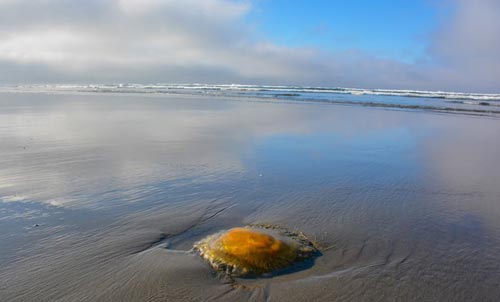Lion's Mane Jellyfish: Something Ouchy on Oregon Coast Lately
Published 11/10/2019 at 5:55 AM PDT
By Oregon Coast Beach Connection staff

Includes exclusive listings; some specials in winter
In Cannon Beach:
Includes rentals not listed anywhere else
In Manzanita, Wheeler, Rockaway Beach:
Some specials for winter
In Pacific City, Oceanside:
Some specials for winter
In Lincoln City:
Some specials for winter
In Depoe Bay, Gleneden Beach:
Some specials for winter
In Newport:
Look for some specials
In Waldport
Some specials for winter
In Yachats, Florence
Some specials for winter
(Oregon Coast) – Something potentially fairly painful has been washing up on the Oregon coast, with Seaside Aquarium this week reporting seeing some Lion’s Mane Jellyfish on the north coast. (Photos courtesy Tiffany Boothe / Seaside Aquarium).
The aquarium’s Tiffany Boothe said unlike just about all jellyfish that wind up on these beaches, these can actually deliver some pain.
“These large jellyfish live for less than a year and can give an unpleasant sting that can last for up to 4 to 5 hours,” she said. “We have also been seeing quite a few large moon jellies too.”
If you see these large jellyfish, avoid them touching them and keep your pets away. Do not walk on them with bare feet. These jellyfish are dead, luckily, but their effect can still be present if you make contact with the underside or some of its tentacles.
Moon jellies cannot harm humans, but some people have minor reactions if they come in contact with the tentacles.
Lion’s Mane jellyfish are fairly common to the waters off the Oregon coast, but they don’t wash up with regularity. Generally, they’re found in the upper 60 feet of ocean layer not too far offshore. Their habitat ranges from Alaska down to California.

Moon jellies (courtesy Oregon coast's Seaside Aquarium) are translucent
They are the biggest jellyfish species in the world, in fact. But they also come with a nasty bundle of tentacles which can get over 100 in count, each containing stinging cells called nematocytes. These can stretch as long as 25 feet. It’s mostly their prey in the ocean that have to watch out, as most healthy people will simply get a painful rash. Their sting has been described as being like that of a bee. However, other humans react much more harshly, including serious blisters that are extremely painful, muscle cramps, issues with breathing – and in some cases a sting has killed people.
They are beautiful, like all jellyfish, coming with that graceful bell-like body. Some Lion’s Mane jellyfish are enormous, with the record being 120 feet long, according to Oregon Coast Aquarium. That is actually longer than the largest whale - a blue whale.
These large blobs on the beach were notorious for being part of a strange and uncomfortable incident in 2011 on the Washington coast. In October of that year, a massive amount of small Lion’s Mane jellies along with sea nettle jellyfish of various colors flooded the waters of Port Angeles.
Like the moon jelly, Lion’s Mane jellies have no means of propelling themselves in the open waters, so if the currents and winds dictate they get swept onto shore.
Moon jellies – which technically aren’t really jellyfish – are known as Aurelia aurita, and they are boneless and brainless.
“This species of jellyfish ranges from Alaska to California, and is the proverbial ‘drifter,’ as it floats along wherever the ocean’s current takes it,” Boothe said. “They eat tiny marine life such as plankton and diatoms, which they pick up with the tiny hair-like tentacles that lace the outside edge of the jellyfish. Though they sting their prey, us large, thick-skinned humans cannot be harmed by this jelly.”
Moon jellies that show up on the beaches are about one foot to four feet in diameter. Oregon Coast Hotels in this area - Where to eat - Maps - Virtual Tours
Cannon Beach Lodging
Nehalem Bay Lodgings
Manzanita Hotels, Lodging
Three Capes Lodging
Pacific City Hotels, Lodging
Lincoln City Lodging
Depoe Bay Lodging
Newport Lodging
Waldport Lodging
Yachats Lodging
Oregon Coast Vacation Rentals
Oregon Coast Lodging Specials

Lion's Mane Jellyfish above
More About Oregon Coast hotels, lodging.....
More About Oregon Coast Restaurants, Dining.....
LATEST Related Oregon Coast Articles
Happy ending for the elephant seal with tales from Oceanside to Long Beach. Marine sciences
Winema Wayfinding Point or Pacific Crest Wayside: an Oregon Coast Puzzle
Between Neskowin and Pacific City sits a viewpoint with two names. Travel tips
Oregon Wildlife Experts: Leave Animal Babies Alone in Forests, Coast
People with the right intentions can do the worst. Marine sciences
Authorities Seek Suspect Who Stabbed Baby Seal on Oregon Coast
Attack happened in Neskowin: see the police drawing. Weather
Cannon Beach Sandcastle Contest 2025: N. Oregon Coast Tradition Happens June 21
Started in '64 after a tsunami hit town. Newport events Manzanita events, Cannon Beach events, Seaside events, Astoria events
Florence Rhododendron Festival Hits Florence and Central Oregon Coast Soon
May 15 to 18, food vendors, a carnival, parades and even a classic car cruise. Florence events, Newport events Manzanita events, Cannon Beach events, Seaside events, Astoria events
Oregon's Tillamook Coast Hosts Rigorous Kayaking, Hiking Events in May
Netarts events May 17 and 31; Manzanita events May 14
Above Oregon / Washington Coast in May: Meteors Peak, Galaxy Disappears - and...
A sky full of possibilities this month, including a star that might explode. Sciences, astronomy
Back to Oregon Coast
Contact Advertise on BeachConnection.net
All Content, unless otherwise attributed, copyright BeachConnection.net Unauthorized use or publication is not permitted
















































